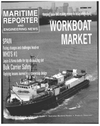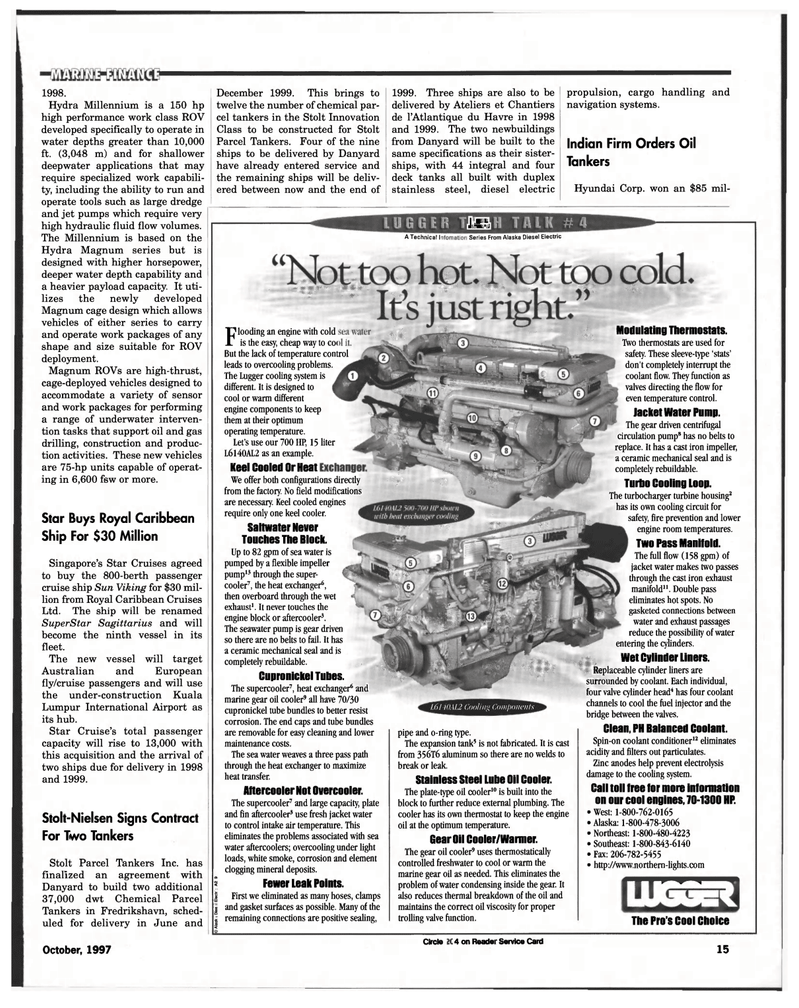
Page 15: of Maritime Reporter Magazine (October 1997)
Read this page in Pdf, Flash or Html5 edition of October 1997 Maritime Reporter Magazine
1998.
Hydra Millennium is a 150 hp high performance work class ROV developed specifically to operate in water depths greater than 10,000 ft. (3,048 m) and for shallower deepwater applications that may require specialized work capabili- ty, including the ability to run and operate tools such as large dredge and jet pumps which require very high hydraulic fluid flow volumes.
The Millennium is based on the
Hydra Magnum series but is designed with higher horsepower, deeper water depth capability and a heavier payload capacity. It uti- lizes the newly developed
Magnum cage design which allows vehicles of either series to carry and operate work packages of any shape and size suitable for ROV deployment.
Magnum ROVs are high-thrust, cage-deployed vehicles designed to accommodate a variety of sensor and work packages for performing a range of underwater interven- tion tasks that support oil and gas drilling, construction and produc- tion activities. These new vehicles are 75-hp units capable of operat- ing in 6,600 fsw or more.
Star Buys Royal Caribbean
Ship For $30 Million
Singapore's Star Cruises agreed to buy the 800-berth passenger cruise ship Sun Viking for $30 mil- lion from Royal Caribbean Cruises
Ltd. The ship will be renamed
SuperStar Sagittarius and will become the ninth vessel in its fleet.
The new vessel will target
Australian and European fly/cruise passengers and will use the under-construction Kuala
Lumpur International Airport as its hub.
Star Cruise's total passenger capacity will rise to 13,000 with this acquisition and the arrival of two ships due for delivery in 1998 and 1999.
December 1999. This brings to twelve the number of chemical par- cel tankers in the Stolt Innovation
Class to be constructed for Stolt
Parcel Tankers. Four of the nine ships to be delivered by Danyard have already entered service and the remaining ships will be deliv- ered between now and the end of 1999. Three ships are also to be delivered by Ateliers et Chantiers de l'Atlantique du Havre in 1998 and 1999. The two newbuildings from Danyard will be built to the same specifications as their sister- ships, with 44 integral and four deck tanks all built with duplex stainless steel, diesel electric t- 1 ^ M * J
Series From Alaska Diesel Electric propulsion, cargo handling and navigation systems.
Indian Firm Orders Oil
Tankers
Hyundai Corp. won an $85 mil-
A Technical I
Stolt-Nielsen Signs Contract
For Two Tankers
Stolt Parcel Tankers Inc. has finalized an agreement with .
Danyard to build two additional * 37,000 dwt Chemical Parcel I
Tankers in Fredrikshavn, sched- 1 uled for delivery in June and |
L6140AL2 Cooling Components
WW*
Modulating Thermostats.
Two thermostats are used for safety. These sleeve-type 'stats' don't completely interrupt the coolant flow. They function as valves directing the flow for even temperature control.
Jacket Water Pump.
The gear driven centrifugal circulation pump8 has no belts to replace. It has a cast iron impeller, a ceramic mechanical seal and is completely rebuildable.
Turbo Cooling loop.
The turbocharger turbine housing2 has its own cooling circuit for safety, fire prevention and lower engine room temperatures.
Two Pass Manifold.
The M flow (158 gpm) of jacket water makes two passes through the cast iron exhaust manifold11. Double pass eliminates hot spots. No gasketed connections between water and exhaust passages reduce the possibility of water entering the cylinders.
Wet Cylinder Liners.
Replaceable cylinder liners are surrounded by coolant. Each individual, four valve cylinder head4 has four coolant channels to cool the fuel injector and the bridge between the valves.
Clean, PH Balanced Coolant.
Spin-on coolant conditioner12 eliminates acidity and filters out particulates.
Zinc anodes help prevent electrolysis damage to the cooling system.
Call toll free for more information on our cool engines, 70-1300 HP. • West: 1-800-762-0165 • Alaska: 1-800-478-3006 • Northeast: 1-800-480-4223 • Southeast: 1-800-843-6140 • Fax: 206-782-5455 • http://www.northern-lights.com
The Pro's Cool Choice
Aftercooler Not Overcooler.
The supercooler7 and large capacity, plate and fin aftercooler3 use fresh jacket water to control intake air temperature. This eliminates the problems associated with sea water aftercoolers; overcooling under light loads, white smoke, corrosion and element clogging mineral deposits.
Fewer Leak Points.
First we eliminated as many hoses, clamps and gasket surfaces as possible. Many of the remaining connections are positive sealing, pipe and o-ring type.
The expansion tank5 is not fabricated. It is cast from 356T6 aluminum so there are no welds to break or leak.
Stainless Steel Lube Oil Cooler.
The plate-type oil cooler10 is built into the block to further reduce external plumbing. The cooler has its own thermostat to keep the engine oil at the optimum temperature.
Gear Oil Cooler/Warmer.
The gear oil cooler9 uses thermostatically controlled freshwater to cool or warm the marine gear oil as needed. This eliminates the problem of water condensing inside the gear. It also reduces thermal breakdown of the oil and maintains the correct oil viscosity for proper trolling valve function.
Flooding an engine with cold is the easy, cheap way to coi
But the lack of temperature control leads to overcooling problems.
The Lugger cooling system is different. It is designed to cool or warm different engine components to keep them at their optimum operating temperature.
Let's use our 700 HP, 15 liter
L6140AL2 as an example.
Keel Cooled Or Heat
We offer both configurations directly from the factory. No field modifications are necessary. Keel cooled engines require only one keel cooler.
Saltwater Never
Touches The Block.
Up to 82 gpm of sea water is pumped by a flexible impeller pump13 through the super- cooler7, the heat exchanger6, then overboard through the wet exhaust1. It never touches the engine block or aftercooler3.
The seawater pump is gear driven so there are no belts to fail. It has a ceramic mechanical seal and is completely rebuildable.
Cupronickel Tubes.
The supercooler7, heat exchanger6 and marine gear oil cooler9 all have 70/30 cupronickel tube bundles to better resist corrosion. The end caps and tube bundles are removable for easy cleaning and lower maintenance costs.
The sea water weaves a three pass path through the heat exchanger to maximize heat transfer.
October, 1997
Circle 348 on Reader Service Card 15

 14
14

 16
16
